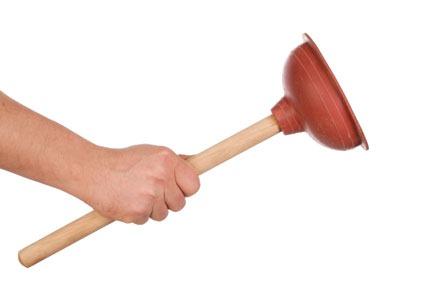The common household plunger is more complicated than it first appears. There are three main types of plungers available to the home consumer, and professional plumbing companies have more advanced plunging tools up their sleeves. All plungers, however, work on the same basic physical principle to break up clogs and restore flow to troubled pipes.
A clog is usually formed from organic matter that collects in a pipe. Rarely, a clog can result from a foreign object such as a childrens’ toy finding its way into the plumbing. This clog prevents water from flowing past it, and can even cause damage to surrounding flooring and walls in the event of an overflow. This backed up water is actually the key to eliminating the stoppage.
Since molecules of water are more densely packed than molecules of air, water does not compress under pressure. This means that when force is applied to water, that force is pushed against whatever contains the water. The mechanical action of depressing the plunger increases the pressure inside the pipe and dislodges the clog.
The cup plunger, with its classic rubber cup attached to a simple wooden shaft, is the most familiar design to the average consumer. Many a frustrated homeowner has labored over a clogged toilet cursing this age-old standby. The simple shape of the cup makes it difficult to form a seal in the bowl of the toilet. In fact, this is because the cup plunger is not designed for toilets at all.
It’s actually meant to fit over the drains of sinks and tubs. Clumps of hair and soap scum stand no chance against the tried and true cup plunger.
To defeat a clogged toilet, a small but vital change must be made in the design of the plunger. The flange plunger has a modified cup that forms a tighter seal in the toilet bowl and allows for a longer plunging motion to be made. Additionally, the shape of the cup allows more water to be held inside the plunger itself. Since water does not compress under pressure the way that air does, this makes for a stronger, more efficient stroke.
The third type of plunger available to homeowners is called the bellows plunger. This unusually-shaped plunger takes the flange plunger’s technique to the next level. The bellows plunger has a tall accordion-shaped cup with a high interior volume. When a stubborn clog won’t budge, the bellows plunger is the right tool for the job. To work optimally, the cup must be filled with water, and the seal must be tight.
The shape of the bellows plunger allows the cup to fold downwards, shifting more pressure along the pipes to the clog with less effort for the user.
For any of the plunger styles, a long, slow thrust is more effective than a quick jab to clear the pipes. If there’s an overflow drain, be sure to block it. If you don’t, the applied pressure will send the backed up water out of the overflow instead of pushing it against the clog. Assure that plunger cup forms a solid seal around the drain, and be sure to use the right plunger for the situation.
Charlie Teschner started MESA Plumbing, Heating, and Cooling in 1982. Charlie has a journeyman and master plumber’s license. He was raised with a strong work ethic and he now applies those values to tasks such as heating repair in Boulder.
